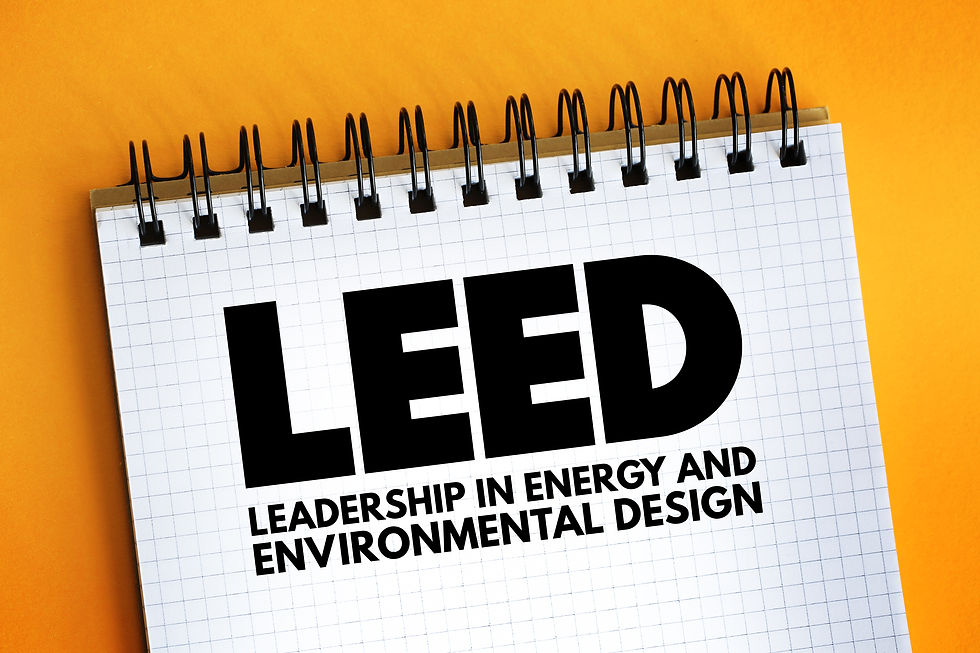
1 Sept 2023
LEED-certified buildings aim to lower operating costs, reduce waste, conserve energy and water, and provide healthier spaces for occupants.
Sustainable and eco-friendly building practices are becoming increasingly important worldwide. LEED (Leadership in Energy and Environmental Design) is one of the most widely used green building certification programs. LEED-certified buildings aim to lower operating costs, reduce waste, conserve energy and water, and provide healthier spaces for occupants.
As Africa continues to grow and develop, LEED principles can help guide the construction of high-performing, environmentally friendly buildings.
What is LEED Certification?

LEED is an international certification system developed by the United States Green Building Council (USGBC) that sets standards for environmentally sustainable construction. The LEED rating system evaluates buildings across several categories:
Location and Transportation - Site selection and access to public transit
Sustainable Sites - Management of environmental impacts on-site
Water Efficiency - Water conservation and efficiency
Energy and Atmosphere - Energy performance and carbon emissions
Materials and Resources - Sustainable sourcing and waste management
Indoor Environmental Quality - Air quality, lighting and thermal comfort
Innovation in Design - Innovative strategies and regional priorities
Regional Priority - Local environmental priorities
Based on the number of points earned, buildings can achieve Certified, Silver, Gold, or Platinum LEED certification. The more sustainable features incorporated into the building's design, construction, and operations, the higher the LEED rating.
Benefits of LEED-Certified Buildings

Constructing LEED-certified buildings offers many benefits, both economic and environmental.
Lower Operating Costs
LEED buildings are designed to use significantly less water and energy compared to conventional buildings. Installation of low-flow and high-efficiency plumbing fixtures, intelligent HVAC systems, LED lighting, and thermal insulation all contribute to substantially reduced utility bills. The upfront investment in energy-efficient systems pays off over the life of the building.
Healthier Indoor Environments
LEED promotes better ventilation, ample daylighting, the use of low-VOC materials, and superior moisture control. This creates healthier indoor air quality, improving comfort, productivity, and well-being.
Studies show employees working in LEED-certified spaces experience fewer sick days and improved job satisfaction.
Conservation of Resources
Sustainable construction practices reduce waste of water, energy, and raw materials during building operations. Reusing existing building structures as part of new developments saves construction materials. Recycling programs and efficient water systems further conserve resources.
Lower Environmental Impact
LEED buildings aim to reduce greenhouse gas emissions. Location near public transit, renewable energy systems like solar panels, and efficient HVAC equipment all limit a building's carbon footprint over its lifecycle. LEED principles help minimize the impact on the local environment through every phase of development.
Corporate Social Responsibility
Constructing an eco-friendly building demonstrates an organization's commitment to sustainability and social responsibility. LEED certification provides third-party validation of green building best practices. It's a tangible way for companies and institutions to show environmental leadership.
Benefits of LEED in Africa

Constructing LEED-certified buildings in Africa offers specific benefits given the country's climate and stage of development:
Water conservation - With sensitivities around water scarcity in Africa, limiting water use is essential. Low-flow plumbing fixtures drastically reduce consumption, while rainwater harvesting systems help collect and reuse water.
Energy efficiency - Reducing reliance on fossil fuels lowers energy costs and carbon emissions. Solar panels and maximizing daylight harness renewable resources. Insulation well-suited to Africa's climate reduces HVAC needs.
Local materials sourcing - Using locally sourced sustainable building materials supports the African industry. LEED rewards the use of regional materials and short supply chains.
Healthy interiors - Excellent thermal comfort and ample fresh air create welcoming learning environments in schools. Workplace productivity thrives in buildings with quality indoor air.
Leadership in sustainability - LEED certification allows African businesses and organizations to demonstrate commitment to environmental best practices in a globally recognized framework.
Resilience - LEED principles enhance buildings' resilience to extreme weather events, natural disasters, and changing climate conditions. Durability and energy independence ensure operational continuity.
Challenges of LEED in Africa
Achieving LEED certification in Africa also comes with certain challenges:
Upfront costs - Integrating LEED standards may increase initial construction and design costs. Access to green building financing mechanisms can help offset these expenses.
New contractor skills - Builders, architects, and engineers need training on sustainable design and construction methods. Investing in education ensures quality implementation.
Limited materials access - Sourcing specialized green building products locally remains difficult. But this also presents business opportunities for manufacturers and suppliers.
LEED program awareness - The LEED rating system is still gaining recognition in the African market. Further education on its benefits drives market demand.
The Future of LEED in Africa

As sustainable construction practices gain traction globally, LEED has excellent growth potential in the African market. Early adopters of LEED certification standards are well-positioned to become leaders in green building.
From small residential projects to large commercial developments, applying LEED principles can enhance environmental sustainability across Africa's built environment. With proper education, available financing, government incentives, and a commitment to conservation, LEED offers tremendous value for Africa's future.
The construction industry must take responsibility for its large carbon footprint. With buildings accounting for 39% of carbon emissions globally, sustainable design and operation is crucial. LEED provides a framework for greener development in Africa.
As more projects pursue LEED certification, they set an important example for the continent and the region. Constructing LEED certified buildings signifies Africa's commitment to environmental leadership.
